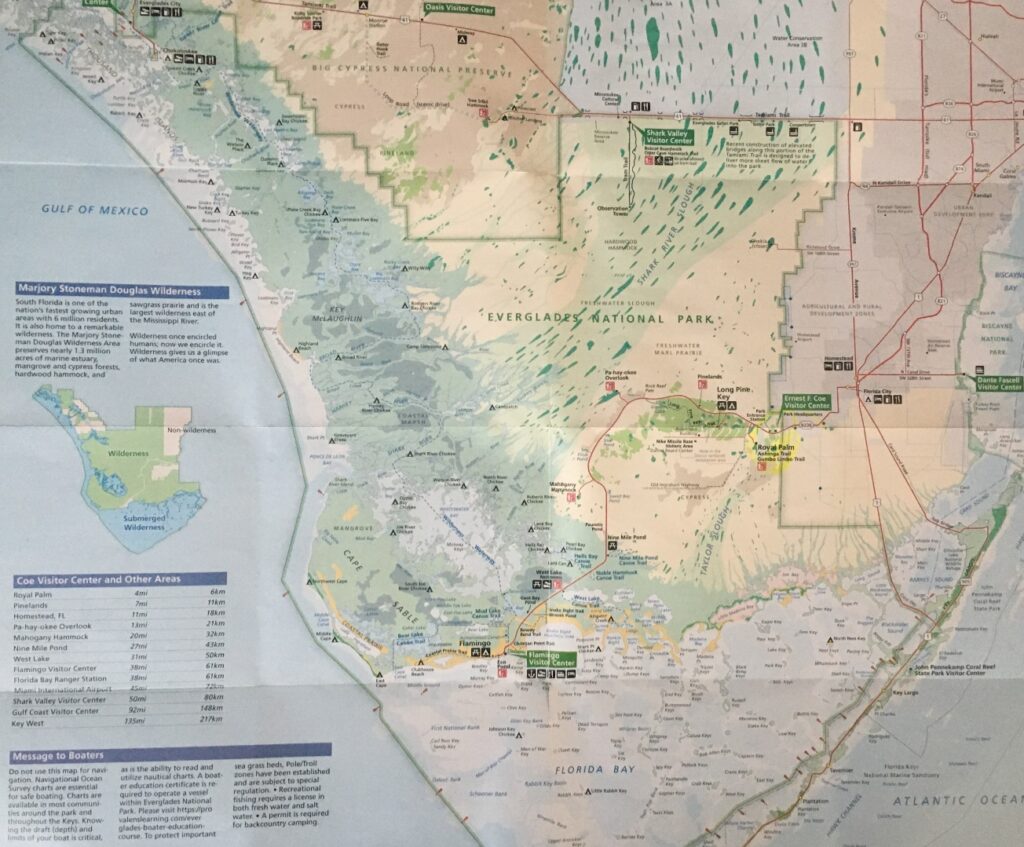Introduction to Everglades National Park
Everglades National Park is a vast natural treasure located in southern Florida, spanning an impressive 1.5 million acres. The park is of great importance and significance due to its unique and diverse ecosystem, as well as its rich history. The park, established in 1947, is located in Miami-Dade, Monroe, and Collier counties. It is the largest tropical wilderness in the United States, and its size is comparable to the states of Rhode Island and Delaware combined. This immense size allows for a wide range of natural features and habitats to exist within the park.
Natural Features of Everglades National Park
One of the most fascinating aspects of Everglades National Park is its unique ecosystem and biodiversity. The park is situated at the southern end of the Florida peninsula, where freshwater from Lake Okeechobee merges with the saltwater of the Gulf of Mexico. This creates a delicate balance of habitats, including sawgrass marshes, hardwood hammocks, coastal prairies, and mangrove forests. Within these diverse habitats, an incredible array of wildlife can be found. Everglades National Park is home to over 350 species of birds, including the iconic American alligator, elusive Florida panther, manatees, and numerous species of fish. The park is also a haven for endangered species, such as the Cape Sable seaside sparrow and the Key deer.
The park is home to an incredible variety of plant and animal species, making it one of the most biodiverse areas in the United States. From alligators and panthers to rare orchids and vibrant bird species, the park’s wildlife will leave you in awe. Within Everglades National Park, you’ll discover a range of habitats and landscapes that further showcase the park’s natural beauty. From vast sawgrass prairies to mangrove forests and cypress swamps, each area boasts its own unique charm. The park also features stunning waterways, including the shallow and slow-moving River of Grass, which is a defining characteristic of the Everglades.
Activities and Attractions in Everglades National Park
When visiting Everglades National Park, there are numerous activities and attractions to keep you entertained. Wildlife watching is a popular pastime, as the park provides ample opportunities to spot various species in their natural habitat. Birding enthusiasts will be especially delighted, as the park is a haven for over 360 species of birds, making it a bird-watcher’s paradise.
For those seeking more adventure, boat tours and canoeing or kayaking adventures are fantastic options. These allow you to explore the park’s waterways, offering a unique perspective on the Everglades’ stunning landscapes. And if you prefer to keep your feet on solid ground, hiking and camping options abound throughout the park, offering opportunities to immerse yourself in nature and experience the beauty up close.
The Anhinga Trail and Shark Valley Observation Tower are prime locations for birdwatching and observing alligators. Boat tours are another exciting way to explore the park and its diverse landscapes. From airboat rides to guided tours, visitors can witness the beauty of the mangrove forests and the vast grassy expanses of the sawgrass prairies. Hiking opportunities abound in the park, with trails ranging from short, easy walks to longer, more challenging treks. For those who wish to immerse themselves in the park’s natural wonders, camping options are available. Campsites are situated throughout the park, providing visitors with a chance to experience the sounds and sights of the Everglades at night.
Conservation and Environmental Issues in Everglades National Park
While Everglades National Park is a natural wonder, it also faces numerous conservation and environmental challenges. One of the primary threats is the alteration of natural water flow due to urban development and agriculture. This disruption affects the delicate balance of fresh and saltwater habitats, impacting the park’s diverse flora and fauna. Efforts are underway to preserve and restore the park’s ecosystem. Restoration projects aim to improve water quality and flow, while also protecting critical habitats. Additionally, initiatives are focused on managing invasive species and ensuring the continued survival of endangered species.
The park’s delicate ecosystem is threatened by various factors, including habitat loss, pollution, and invasive species. There are ongoing efforts and initiatives dedicated to the preservation and restoration of the Everglades. These initiatives aim to protect the park’s ecosystem and ensure its survival for future generations.
Visitor Information and Tips for Visiting Everglades National Park
Before visiting Everglades National Park, it is important to be aware of certain information and tips. Entrance fees and permits are required, with different rates depending on the type of visit and duration. It is advisable to check the park’s website for up-to-date information on fees and permits. The best time to visit the park is during the winter and spring months, when temperatures are milder and mosquitoes are less active. However, weather considerations should also be taken into account, as hurricanes and tropical storms can occur in the area during the summer months.
If you’re planning a visit to Everglades National Park, it’s essential to be armed with some visitor information and tips. The park requires an entrance fee or a valid National Parks Pass, which grants access to the park for a specified period. It’s also important to consider the best time to visit, as the Everglades can be hot and humid during the summer months. Winter and early spring are often considered the ideal seasons to explore the park, as the weather is more comfortable.
In conclusion, Everglades National Park is a true gem of natural beauty and biodiversity. Its unique ecosystem, diverse landscapes, and abundant wildlife make it a paradise for outdoor enthusiasts. While the park faces environmental challenges, its preservation and restoration efforts provide hope for the future of this magnificent wilderness. So, pack your bags, grab your camera, and get ready to explore and fall in love with the Everglades National Park.
Lastly, visitors should be aware of safety guidelines and precautions. It is important to stay on designated trails, be cautious of wildlife encounters, and avoid swimming in unfamiliar waters. This includes being aware of your surroundings, especially when encountering wildlife, and following park rules regarding camping and hiking. By respecting the park and its inhabitants, you can ensure a safe and enjoyable experience for both yourself and the ecosystem.
Everglades National Park is a remarkable destination that offers a wealth of natural wonders and experiences. From its unique ecosystem and biodiversity to its various activities and attractions, the park provides visitors with an opportunity to immerse themselves in one of the most incredible natural landscapes in the United States. By understanding the importance of conservation and adhering to safety guidelines, visitors can ensure the continued preservation and enjoyment of Everglades National Park for generations to come.

